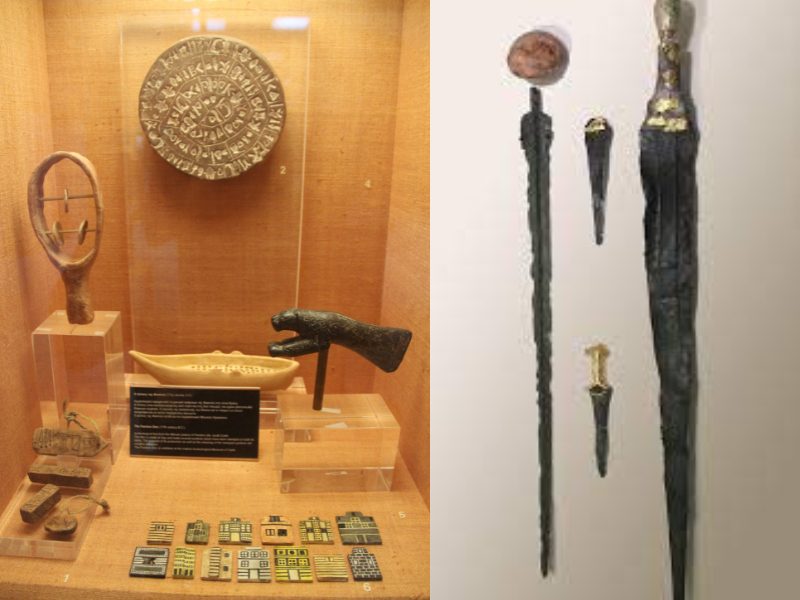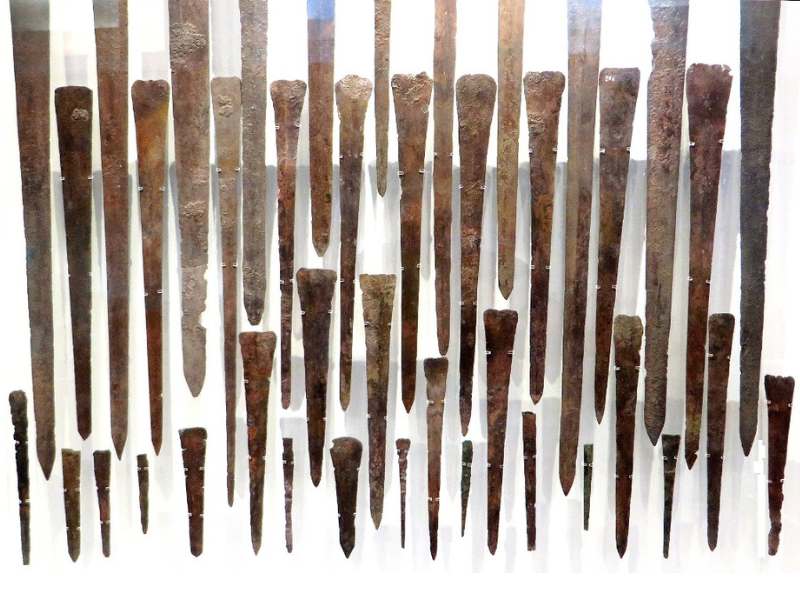Table of Contents
Introduction
Flourishing during the Bronze Age, the Minoan civilization is renowned for its labyrinthine palaces, vivid frescoes, and enigmatic script. Yet, an often overlooked aspect of this advanced society is its weaponry, a domain where artistry met utility in the crucible of ancient metallurgy.
In this exploration, we delve into the evolution of Minoan weaponry, tracing the transition from rudimentary tools to sophisticated instruments of war and ceremony. The Minoans, known for their peaceful nature and thriving trade networks, developed a range of weapons that not only served practical purposes in hunting and combat but also held significant cultural and ceremonial value. This journey through time will unveil the technological prowess and artistic flair that characterized Minoan arms, revealing a facet of this ancient civilization that contributed to its enduring legacy in the annals of history.
Early Minoan Period: The Dawn of Weaponry
The story of Minoan weaponry begins in the Early Minoan period, a time when Crete was stepping into the broader narrative of human civilization. Dating back to approximately 3000-2100 BC, this era was marked by the emergence of small Minoan communities, the cultivation of agriculture, and the nascent stages of what would become a highly sophisticated society. During this period, the Minoans relied primarily on simple but effective tools and weapons, largely fashioned from locally sourced materials like stone, bone, and wood.
Archaeological excavations across Crete have unearthed a variety of these early implements. Stone tools, including basic axes and knives, were commonplace, reflecting a society that was still deeply intertwined with nature. The rudimentary spears, often tipped with flint or obsidian, provided a glimpse into the hunting practices of the time and the early defensive mechanisms adopted by these burgeoning communities. These findings, often accompanied by pottery and other artifacts, offer a window into an era where survival and utility were paramount, setting the stage for the technological advancements that were to come. The simplicity of these early weapons belies their significance – they were the precursors to a period of remarkable innovation and artistic expression in Minoan arms.

Middle Minoan Period: Technological Advancements
As we venture into the Middle Minoan period, roughly spanning 2100-1600 BC, we witness a significant shift in the realm of weaponry, mirroring the broader cultural and technological advancements of the Minoans. This era is characterized by the advent of metallurgy, with bronze emerging as a revolutionary material in weapon crafting. The introduction of bronze, an alloy of copper and tin, marked a dramatic improvement in both the durability and effectiveness of Minoan weapons, enabling the creation of sharper, stronger, and more versatile tools of war.
The influence of trade, particularly with the Aegean and Near Eastern civilizations, played a pivotal role in this transformation. The exchange of ideas and materials led to a rapid evolution in weapon designs, with the Minoans adopting and adapting techniques from their neighbors. Swords, which began to feature prominently during this period, became more refined, with evidence of both straight and curved blades. Daggers, previously rudimentary in design, were now crafted with intricate hilts and longer, more lethal blades. Similarly, spears underwent a metamorphosis, evolving from simple wooden shafts to more sophisticated designs incorporating metal tips, enhancing their penetrative power.
The Middle Minoan period thus stands as a testament to the Minoans’ ingenuity and adaptability. The weapons from this era not only reflect a society becoming more proficient in the art of metallurgy but also hint at the changing dynamics of Minoan culture, where trade, craftsmanship, and warfare began to leave a more pronounced imprint on the civilization’s trajectory.
Late Minoan Period: Mastery of Weaponry
During the Late Minoan period, approximately spanning from 1600 to 1100 BC, the island of Crete witnessed the zenith of its civilization’s prowess in weaponry. This era, often regarded as the golden age of Minoan culture, showcased a mastery of metallurgy and craftsmanship that resulted in some of the most exquisite and effective weapons of the ancient world. The Minoans, now at the height of their power, produced arms that were not only functional but also works of art, reflecting the sophisticated aesthetics of their society.
The swords of this period exemplify the Minoans’ advanced metalworking skills. These weapons, varying in size and design, often featured elegantly tapered blades with reinforced hilts for better grip and balance. Some swords were crafted for ceremonial purposes, adorned with intricate designs and symbols, possibly reflecting the owners’ status or the swords’ ritualistic roles. Daggers, too, became more elaborate, with finely crafted blades and handles. The discovery of several bronze daggers inlaid with gold and silver suggests a high degree of specialization in weapon-making.
Spears and arrows also saw significant improvements. The use of bronze enabled the production of sharper, more aerodynamic points, increasing their lethality and effectiveness in both hunting and combat. This period also saw the introduction of composite bows, enhancing the Minoans’ capabilities in archery.
The weaponry of the Late Minoan period thus not only signifies the technological advancements of the time but also reflects the complex social and cultural fabric of Minoan society. The sophistication of these weapons indicates a civilization that valued beauty and efficacy in equal measure, showcasing the Minoans’ role as pioneers in the art of ancient warfare and metalwork.
Weaponry and Society: A Cultural Perspective
The impact of weaponry in Minoan Crete extended far beyond the realms of warfare and hunting; it was deeply intertwined with the society’s cultural and religious fabric. In Minoan culture, weapons were not merely tools for survival or combat; they were symbols of power, status, and divine connection. This section of our exploration delves into the societal significance of Minoan weapons, shedding light on how they influenced and reflected the values and beliefs of this ancient civilization.
One of the most striking aspects of Minoan weaponry is its presence in various forms of art, including frescoes, pottery, and jewelry. Depictions of swords, spears, and daggers in these artworks often accompany scenes of religious rituals or significant cultural events, suggesting a symbolic significance beyond their practical use. For instance, the ceremonial daggers unearthed in palatial complexes, intricately designed and often made with precious metals, indicate a ritualistic purpose, possibly used in offerings or as symbols of divine protection.
Moreover, the role of weapons in social hierarchy cannot be overlooked. Ownership of finely crafted weapons, especially those adorned with gold, silver, or intricate carvings, was likely a privilege of the elite. Such weapons would have been a clear marker of status, power, and wealth, possibly used in ceremonial contexts or as grave goods for high-ranking individuals.
In summary, Minoan weapons were more than just instruments of war; they were integral to the societal and religious structures of the civilization. Their presence in art, their use in rituals, and their role as status symbols all point to a society where weaponry was embedded in the very identity and ethos of the Minoans, reflecting a civilization where elegance, spirituality, and power converged in the craftsmanship of arms.
Decline and Legacy
The twilight of the Minoan civilization, marked by its gradual decline around 1100 BC, brought significant changes, not only in the political and social landscape of Crete but also in the realm of weaponry. This period, characterized by a series of natural disasters, invasions, and eventual absorption into Mycenaean Greece, witnessed a waning of the once-flourishing Minoan culture. Consequently, the art of weapon-making, which had reached its zenith during the Late Minoan period, began to fade, leaving behind a legacy that would influence subsequent cultures and epochs.
The decline in the quality and quantity of weapons produced during this period is evident from archaeological findings. The once-sophisticated designs and craftsmanship gave way to more rudimentary forms, likely due to the disruption of trade routes and the socio-economic turmoil that gripped the island. However, the influence of Minoan weaponry did not wane entirely. The Mycenaeans, who dominated the Greek mainland following the decline of the Minoans, adopted and adapted many aspects of Minoan culture, including their weaponry techniques. This fusion of styles and knowledge can be seen in the weapons from the Mycenaean period, which bear resemblance to Minoan designs yet feature their distinct characteristics.
The legacy of Minoan weaponry extends beyond its immediate historical context. The sophistication and artistry of Minoan arms have been a subject of fascination and study for historians and archaeologists. They offer insights into the technological advancements of the Bronze Age and the cultural significance of weapons in ancient societies. The Minoan civilization, with its unique blend of artistry, craftsmanship, and innovation in weaponry, continues to captivate the imagination, offering a window into a world where arms were not just tools of war but symbols of a civilization’s identity and prowess.

Conclusion
In our journey through the evolution of weaponry in Minoan Crete, we have traversed from the rudimentary stone tools of the Early Minoan period to the highly sophisticated bronze arms of the Late Minoan era. This progression not only reflects the technological advancements of the time but also offers a unique lens into the cultural, social, and spiritual life of the Minoans. The weapons of Crete were more than mere instruments of warfare; they were embodiments of craftsmanship, symbols of status, and bearers of cultural identity.
This exploration underscores the importance of weaponry in understanding the broader narrative of the Minoan civilization. The sophistication and artistry of Minoan weapons speak volumes about the skills of their craftsmen and the values of their society. It also highlights the interconnectedness of ancient civilizations, as seen in the influence of trade and cultural exchange on Minoan weapon designs.
As we conclude, it becomes evident that the study of ancient weaponry is not just about understanding tools of war but about piecing together the mosaic of human history. The legacy of Minoan weaponry, with its blend of functionality, artistry, and symbolism, continues to be a fascinating chapter in the study of ancient civilizations, offering enduring insights into the ingenuity and spirit of the Minoans. Their contribution to the art of warfare and metallurgy remains a testament to their role as pioneers in the ancient world, leaving an indelible mark on the tapestry of history.


